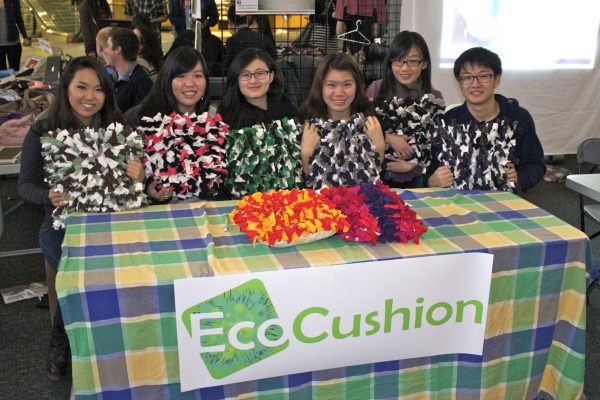Combining innovation with sustainability
Mar 24, 2013
Undergraduate students create innovative products to aid Vancouver’s green goals.
The City of Vancouver has set itself the ambitious target of becoming the greenest city in the world by 2020. And while the action plan set out by the city is comprehensive, many smaller initiatives in the community are often overlooked.
One such example of these initiatives is occurring at the Beedie School of Business, taking advantage of a partnership with the City of Vancouver and utilizing the creative talents of a group of undergraduate students to combine sustainability with innovation to create new product concepts for environmentally friendly results.
Since late 2011, Beedie School of Business lecturer Lisa Papania has assigned students within her New Product Development and Design class the task of creating innovative new products and concepts which are designed to help the city achieve its goals. Papania believes the model of combining sustainability with innovation has great potential.
“Through my research I have found that sustainability makes an extremely interesting context for innovation,” says Papania. “How we define sustainability is constantly evolving, as more research is undertaken into what is affecting the planet. This means that in the field of sustainability, innovation is also constantly occurring, and the two concepts complement each other perfectly.”
Although Papania has been teaching the class for some time, she was keen to find a way to give the student projects real world context. She found what she was looking for through a partnership with CityStudio, a collaboration between the City of Vancouver, the Vancouver Economic Commission, and the six public post-secondary education institutions in the Lower Mainland (BCIT, Emily Carr University, Langara College, SFU, UBC and Vancouver Community College).
The CityStudio initiative brings students, city staff, professionals and citizens together to create a sustainable city. Through the partnership, Papania was able to set her students goals in line with the City of Vancouver’s sustainability targets.
Since launching the partnership, Papania’s classes have produced some amazing and varied sustainable products and business concepts. While her first class under the new partnership was given a broad assignment to develop products in line with one of the city’s ten main goals, her second class received a more specific mandate, focusing on textile waste.
Inspiring sustainable innovation
The idea for the textile project came to Papania when a fellow faculty member asked for recycling solutions for clothing too worn to be donated to charity. After doing some research, she discovered that the issue was a huge problem – approximately 12 million tons of textile waste is generated in North America each year, contributing to some five percent of all landfill.
The figures provided the motivation for Papania’s next class project: creating and marketing products or concepts designed to make use of unwanted fabric and divert it from landfills, while at the same time raising awareness of overconsumption and pollution caused by textile waste.
Some students created products such as SFU-branded laptop sleeves made from donated hooded sweatshirts, and coffee cup sleeves and decorative pillows made from recycled clothing. Others, meanwhile, came up with services designed to encourage recycling of textiles, such as clothes-swapping parties, and craft workshops utilizing recycled garments.
“The textile project resulted in innovative solutions to social problems by encouraging the students to engage with customers and find ways to meet their needs,” says Papania. “It also changed the way the students think about textiles – they are now aware that when clothes are thrown away they merely sit in landfill and just contribute to a wider problem.”
Papania’s current New Product Development and Design students are working on another environmental issue, facing the City of Vancouver – wood waste. Once again the inspiration for the class project presented itself by chance, this time through another of Papania’s undergraduate classes.
Papania was approached by students from ENACTUS SFU about a sustainability-related problem. They described a new process one of their members had developed which turned waste medium-density fibreboard (MDF) into pulp which in turn could be made into paper. The only drawback was that the process resulted in toxic formaldehyde being formed as a by-product.
She set another group of undergraduate students, this time from her Business to Business Marketing class, on finding a solution for the left over formaldehyde, and at the same time creating a marketing plan for the product.
When Papania mentioned this project to CityStudio, they pointed out that the City of Vancouver was introducing a new law banning any wood waste from deconstruction being put into landfills. The conversation instantly gave her the idea for this semester’s class project.
“There is over a million tons of wood waste from deconstruction generated every year right now, for which there are no solutions,” says Papania. “By having my students work with CityStudio and various sources around the city on the problem, we aim to show the government that there is a market for this wood to be put to better use.”
Papania is in no doubt about the importance of the partnership with CityStudio for her students in developing these sustainable initiatives. “It’s exciting to see that the City of Vancouver recognizes that these students are capable of making an impact towards their goals,” she says. “Projects like these demonstrate that taking small steps to address local challenges is the route to solving larger, systemic problems.”

